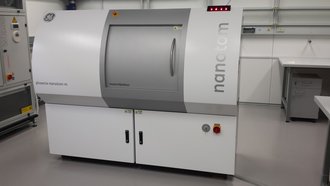Equipment
microCT & nanoCT Computed Tomography System – nanotom m "research|edition"
nanofocus computed tomography system in compact radiation-shielded cabinet
- high-power nanofocus X-ray tube with internal cooling optimized for CT images applying extreme magnification and resolution
- extremely high image quality due to unique temperature stabilized digital detector for a high-dynamic range
- granite based manipulator optimized for long-term stability with air-bearing precision rotary measuring system
- general specifications:
- max. voltage 180 kV
- max. voxel size < 300 nm
- geometric magnification (3D) 1,5-fach bis >300-fach
- max. sample diameter 240 mm
- max. sample height 250 mm
- max. sample weight 3 kg
- temperature stabilized cabinet for high accuracy 3D-coordinate measurements
The instrument enables high-quality investigations of various materials and compounds. These include, for example, the structural analysis of fibre composites, the analysis of pore structures and distributions in metallic or matrix-bound materials, or the time- and location-dependent crack formation or delamination of adhered structures as a result of mechanical or thermal stress. The geometric structures of materials can be analysed via high resolution imaging data, which can be transferred into simulation models using automatic image data processing methods. Furthermore, damage processes and others can be detected non-destructively and with great accuracy while still in development.
Contact:
Dipl.-Ing. Franziska Vogt
Dipl.-Ing. (FH) Martin Hampe
X-ray diffractometer Seifert XRD 3003 TT with Eulerian cradle and X-Y table (Seifert/GE Inspection)
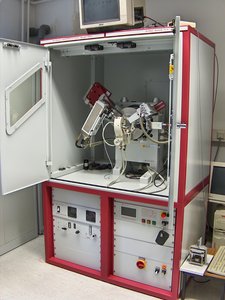
- Euler cradle and X-Y stage for sample positioning
- Fox optics (Fiber Optics for X-Ray) for point focusing, spot size 1 mm
- Position Sensitive Detector (PSD) Fa. Braun, aperture angle 5° 2Theta
- measurements on very small sample quantities, sample material per analysis approx. 0.2 g
- measurement of monolithic samples of complex geometry (calottes, curved surfaces, material inclusions in the mm range)
Services:
- spatially resolved measurements, qualitative and quantitative phase analysis (powders, solids)
X-ray diffractometer XRD 3003 TT MZ VI (Seifert/GE Inspection)
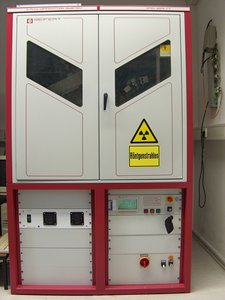
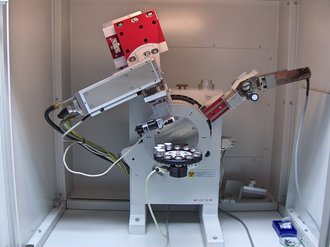
Theta-Theta Diffractometer
12-fold sample changer, scintillation counter tube, radiation Cu-, Cr-, or Mo-Kα
(a) Bragg Brentano diffraction setup (theta/theta).
- examination of powders and planar monolithic samples (slices 10 ≤ d ≤ 50 mm, h ≤ 8 mm).
- mass (quantity) of powdered sample material per analysis ≤ 1.0 g.
(b) GID arrangement and parallel beam geometry (omega/2-theta).
- examination of thin films in grazing incidence.
Services:
- qualitative and quantitative phase analysis (powders, solids).
- RIETVELD method with fundamental parameter approach (BGMN®)
- determination of the amorphous fraction with internal standard (powder)
- determination of the binder type of building materials (powder)
- determination of lattice parameters and crystallite size, if applicable
Contact:
Dr.-Ing. Jens Schneider
Dipl.-Ing. (FH) Stefan Stäblein
Scanning electron microscope with EDS analysis (Hitachi TM3000, Bruker EDX)
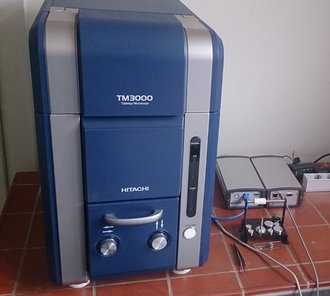
- easy sample observation without special sample preparation (no coating with metal films required)
- viewing of samples with a maximum size of 70 mm in diameter and 50 mm in height
- two different acceleration voltages 5 KV and 15 KV for viewing sensitive samples
- Charge Up Reduction mode for non-conductive samples that tend to charge
- fixing the sample with conductive adhesive pad on the sample carrier
- up to 30.000x magnification
- energy dispersive X-Ray spectrometer (EDX)
- identification of the elements from boron to americium
- mapping function, line scan, and spot function
- graphical user interface
Contact:
Dr.-Ing. Stephan Partschefeld
Differential scanning calorimeter TA Instruments DSC Q200
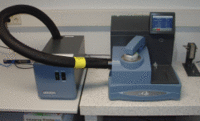
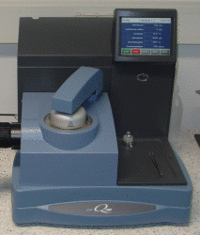
- allows accurate heat flow measurements
- automatic measuring operation due to RCS cooling system within the temperature range of -40 °C to 400 °C
- physical properties of a substance (and/or its reactants) can be measured as a function of temperature or time
- e.g. determination of:
- thermally induced decomposition or transformation processes
- melting and glass transition temperatures
- specific heat capacity
- kinetic observations of chemical reactions
Contact:
Dr. rer. nat. Torben Wiegand
Simultaneous thermal analysis with MS and FTIR coupling
This measuring system with simultaneous measurement data acquisition consists of following components:
(1) Simultaneous thermal analysis apparatus STA 449 F3 Jupiter (NETZSCH):
- simultaneous measurement of thermogravimetry TG and differential scanning calorimetry DSC
- SiC furnace
- temperature range: Room temperature up to 1550 °C
- gas atmospheres: Ar, N2, O2
- vacuum up to 10-4 mbar
- max. sample weight: 35000 mg, resolution: 0.1 µg
- heating rate: 0.001 to 50 K/min
(2) Mass spectrometer coupling (QMS 403 D AëolosÒ):
- mass range: from 1 to 300 m/z
- resolution: 0,5 m/z
- measuring modes: Scan Analog, Scan Bargraph, Multi Ion Detection (MID)
(3) Fourier transform infrared spectrometer coupling (Tensor II, BRUKER):
- qualitative determination of substances and their identification
- gas measuring cell up to 230 °C, ATR/transmission measuring cell
- measuring range: 400 to 3600 cm-1
- medium infrared, spectral resolution: < 0.4 cm-1
(4) Module for control and calibration with Pulse TAÒ technology:
- dosing unit for injection of calibration and reaction gases
- injectable volumes: 0.25 to 1 ml
- defined/stepwise chemical reactions or adsorption of the injected gas with the sample
- quantification of the gases evolved by the sample
Contact:
Dr.-Ing. Jens Schneider
Dipl.-Ing. (FH) Stefan Stäblein
The project supported by the Free State of Thuringia was co-financed by funds from the European Union under the European Regional Development Fund (ERDF).
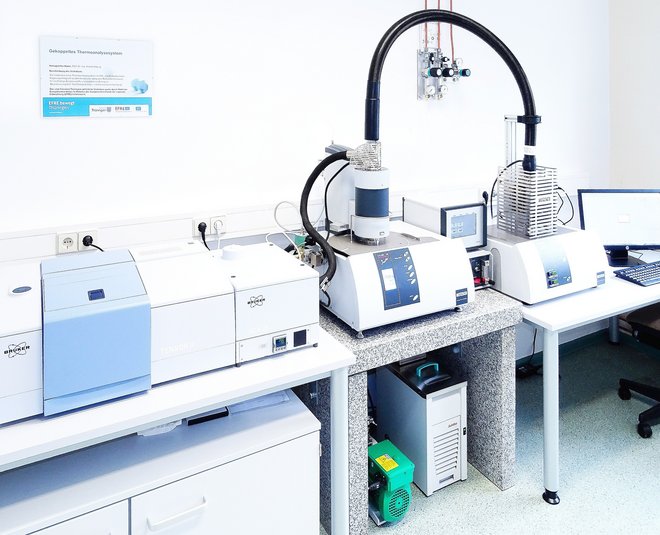

Simultaneous TGA/DSC TA Instruments SDT Q600
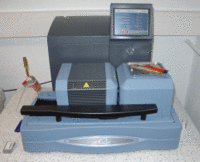
- combined simultaneous measurement of mass change (TGA) and heat flow from room temperature to 1500 °C
- detecting minute mass changes (0.1 mg)
- independent TGA measurements of two samples simultaneously by double bar design
- purging gas flow (N2) flows horizontally through the furnace and directly over the sample and reference crucibles
- causing improvements of baselines, reduction of buoyancy effects, prevention of back diffusion, and efficiently directs the decomposition products away from the sample area
Contact:
Dr. rer. nat. Torben Wiegand
Simultaneous thermal analysis SetSys 16/18 (Setaram)
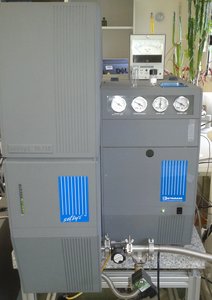
- temperature range: room temperature to 1750 °C depending on the crucible support
- DTA or DSC and TGA
- variable controlled atmospheres: synth. air, argon, oxygen
- dilatometer insert for measurements of thermomechanical properties
Contact:
Dr.-Ing. Jens Schneider
Dipl.-Ing. (FH) Stefan Stäblein
Mixing and reaction calorimeter C80 (Setaram)
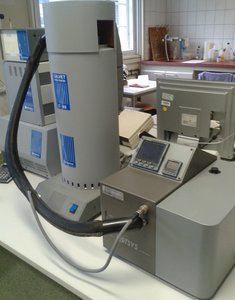
- temperature range: room temperature to 300 °C
- temperature scanning: 0.01 to 2 K/min
- large selection of measuring cells for measurements of reaction and mixing processes (solid-liquid, liquid-liquid, solid-gaseous)
- feasible of determining heat capacity, conductivity, and vapour pressure
- coupling with humidity controller WetSys (5-95 % relative humidity)
Contact:
Dr.-Ing. Jens Schneider
DCA ToniTechnik ToniCal Trio
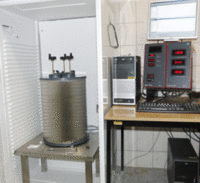
- computer-aided heat flow calorimeter with three measuring cells (differential calorimeter)
- continuous determination of the total heat of hydration of binders, preferably cement
- three measuring cells offset by 120° in a calorimeter vessel, equally thermally insulated
- simultaneous, independent, and time-shifted operation of the three measuring cells in all operating modes such as self-calibration, determination of zero effect and measurement
- measuring sensitivity due to three switchable measuring ranges for a broad variety of cements
- evaluation of the results on the computer with numerical and/or graphic output
Zementkalorimeter MC CAL (C3 Prozesstechnik)
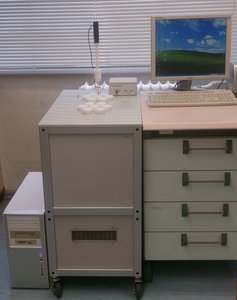
- sample volume: variable, up to approx. 40 ml, depending on sample vessel
- measuring range: ± 2 W
- temperature range: 5-90 °C
- temperature stability: ±0.01 °C
- limit of detectability: 20 µW (5 µW)
- accuracy: ±25 µW (±20 µW)
- baseline stability over 24 h
- drift over 24h: < 40 µW
- deviation: < ±10 µW
- error: < ±24 µW
- short time noise: ± 5 µW
- time constant (with 20 ml H2O): < 2000 s
- investigation of the interaction of binder and additive (retarder / accelerator / superplasticizer)
- quantitative determination of hydration heat (e.g. on NW cements) and determination of the degree of hydration
- analysis of reactivity / setting time as a function of temperature and / or addition of admixtures
- optimization of CaSO4 content
- multi-channel heat flow calorimeter for the cement industry and building chemistry
Contact:
Dr.-Ing. Stephan Partschefeld
Temperature and Thermal Conductivity Meter LFA 447 (Netzsch)
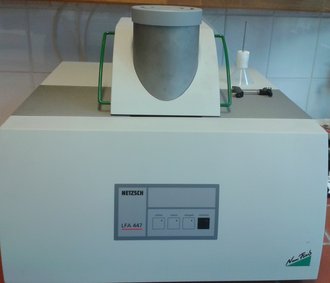
- temperature range: room temperature to 300 °C
- Xenon flash lamp 10J/pulse (adjustable power)
- non-contact temperature rise measurement with IR detector
- measuring range: 0.01 mm²/s to 1000 mm²/s (thermal diffusivity)
- measuring range: < 0.1 W/mK to 2000 W/mK (thermal conductivity)
- specimen diameter: 10.0 mm, 12.7 mm, or 25.4 mm
- specimen edge length: 8.0 mm, 10.0 mm, or 12.7 mm
- specimen thickness: 1 mm to 3 mm thickness
- sample holder for 4 samples
- determination of the specific heat using a comparison method and reference samples
Contact:
Dr.-Ing. Jens Schneider
ICP-OES ACTIVA-M with microwave digestion system MARS 5 Xpress from HORIBA Jobin Yvon GmbH
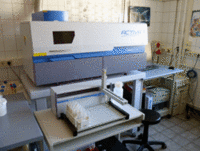
- simultaneous analysis of digestion and eluates
- solid and cement analysis: Na, K, Ca, Mg, Fe, Al, S, Mn, Ti, P
- heavy metal analysis: Cr, Cu, Co, Ni, Mn, Fe, V, Ti, Zn, Cd, Sn, Sr, Mo, Ba, Pb
- other elements on request, except Hg, As
- total Dissolved Solids (TDS) for quantification < 0.5 %, in exceptions up to 3 %
- microwave digestion system
Contact:
Dr.-Ing. Jens Schneider
Gekoppeltes Messsystem FFF-MALS-ICP-MS (Field Flow Fractionation - Multi Angle Light Scattering - Inductive Plasma coupled Mass Spectrometry)
Das gekoppelte Messsystem ist in der Lage, Polymere, Nanopartikel und Mikropartikel unterschiedlicher Struktur, Zusammensetzung und Ladung zu trennen und zu charakterisieren. Das System besteht aus einem Modul für die Fraktionierung und einem Modul für die Detektion. Das Fraktionierungsmodul besteht aus den HPLC-Grundkomponenten Pumpe, Degaser und Autosampler, einem asymmetrischen Fluss-Feldflussfraktionierungs-Kanal (AF4-Kanal), der sowohl durch eine GPC/SEC Säule als auch durch einen AF4-Kanal mit elektrischem Feld ersetzt werden kann. Das Detektionsmodul besteht aus einem Multi-Angle-Laser-Scattering Detektor (MALS), einem Dynamic-Light-Scattering Detektor (DLS), einem Brechungsindex-Detektor (RI), einem UV-Detektor und einem induktiv gekoppelten Plasma – Massenspektrometer (ICP-MS). Mit Hilfe des MALS werden Gyrationsradien der Partikel bestimmt, mit deren Hilfe Molmassen von Polymeren berechnen werden können. In Kombination mit dem hydrodynamischen Radius aus der DLS können Informationen über die Konformation des Polymers und dessen Lösungsstruktur gesammelt werden. Das inline-gekoppelte ICP-MS mit seiner niedrigen Nachweisgrenze und schnellen Detektion gibt Hinweise auf die chemische Zusammensetzung der Partikel. Mit der transienten Aufzeichnung vieler Massespuren soll es möglich werden, organische von anorganischen Partikeln zu unterscheiden.
Ansprechpartner:
Das Gerät wurde im Rahmen der Ausschreibung für Forschungsgroßgeräte nach Art. 91b GG beantragt und zu gleichen Teilen durch den Freistaat Thüringen und die Deutsche Forschungsgemeinschaft finanziert.
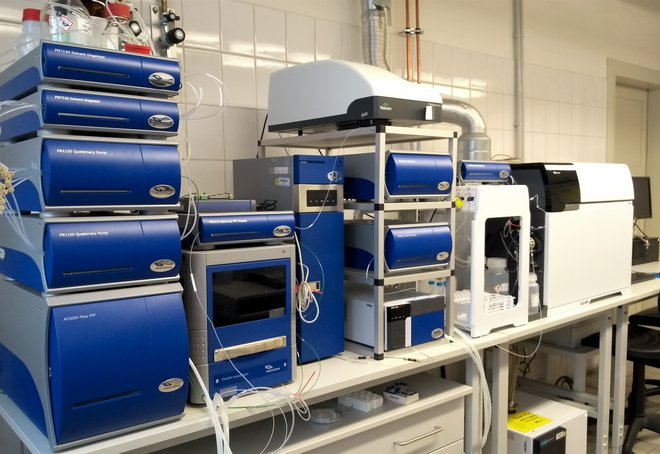
FT-IR microscope Nicolet iN10 with external FT-IR module iZ10 from Thermo Scientific
- recording of infrared spectra in transmission, reflection, and ATR
- spectral range 7800 - 45 cm-1 (KBr - 35 cm-1)
- measurement of solids, powders, liquids, pastes, and gels
- analysis of samples < 50 µm without N2-cooling
- analysis of samples < 10 µm with N2-cooled detector
- gold-plated mirrors for maximum detection sensitivity
- automatic sample table, e.g. for mapping experiments
- heatable compression cell with temperature control up to 200 °C
- simultaneous view and data acquisition in dual monitor mode
- True-View aperture for guaranteed correspondence of view and measuring range
- Standard-FTIR (ATR) using iZ10 module
- feasible of KBr measurements (press, KBr powder and pellet holder available)
- complete software control
- feasible of extensive library search (Aldrich, Hummel, and others)
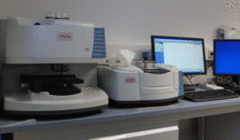
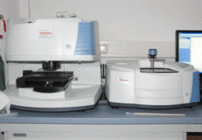

Spectrometer Quantachrome DT 1200

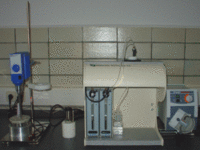
- measurement of surface charges (zeta potential) and pH values
- determination of the stability of suspensions and emulsions
- statements on storage and process stability
- statements on the tendency towards agglomeration
- measurement of particle sizes by acoustic spectrometry
- measurements of wide particle size spectrum (0.1 nm to 100 µm)
- measurement in concentrated dispersion (e. g. cement paste)
- accompanying temperature and conductivity measurement
- 2 titration units for liquids
- feasible of simultaneous measurement of all quantities in the same system
- connection of magnetic stirrer or circulation pump and operation during measurement
Particle Charge Detector MÜTEK PCD-04 from BTG Instruments AB
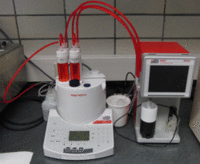
- quantitative determination of colloidal water constituents and particle systems by means of polyelectrolyte titration
- including pH electrode
- including automatic titrator with 2 exchangeable burettes
- software-supported control and evaluation
Spectrophotometer SPECORD® 250 from Analytik Jena
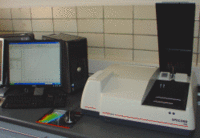

- high-performance, computer-controlled two-beam spectrophotometer
- measurement of transmission, absorbance, and reflection
- determination of the energy of liquid and solid samples
- measurements in the spectral range of 190 - 1100 nm
- suitable for use with high sample throughput
- solutions for special applications with a wide range of accessories
- computer-supported evaluation with the high-performance WinASPECT® software
- current main application in the building industry is the determination of adsorption degrees of polymers in basic research on microstructure formation in PCC
Spectrophotometer UviLine 9100 (Schott Instruments)
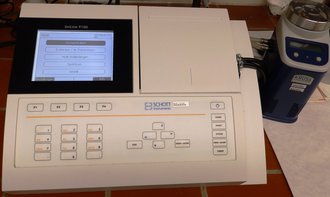
- spectrophotometer
- photometric concentration analytics
- investigation of time-dependent reactions
- measuring range: 320 nm - 1100 nm
- temperature-controlled cuvette holder, Peltier thermostat
Contact:
Dipl.-Ing. Stephan Partschefeld
VIS spectrophotometer DR 3900 (HACH LANGE)
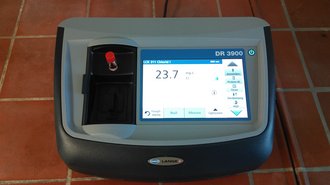
- display modes: transmission (%), absorbance and concentration, scan
- automatic test recognition
- optical system: reference beam technology, spectral
- wavelength range: 320 to 1100 nm
- wavelength accuracy: ± 1.5 nm (wavelength range 340 to 900 nm)
- preprogrammed methods: > 220
Contact:
Uta Maaßen
Universal testing machine TIRAtest 28600 with temperature chamber
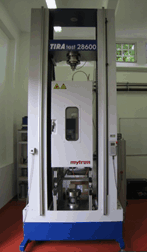
- universal testing machine for tensile, compression, and flexural strength tests on various materials such as
- mortar and concrete
- plastics
- metals
- wood
- glass
- maximum test load: 630 kN (in compression) and 250 kN (in tension)
- temperature-controlled test chamber -40 °C to 180 °C
- equipment for testing a wide range of compression, tensile, and flexural tensile specimens of various materials
- determination of deformations under load
- digital processing of measured values, PC-controlled
Universal testing machine TIRAtest 28100 with temperature chamber
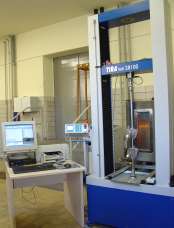
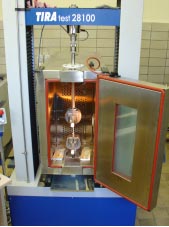
- universal testing machine for tensile, compression, and flexural tests on various materials such as
- mortar and concrete
- plastics
- metals
- wood
- glass
- load measuring range up to 2 kN, 20 kN, and 100 kN at 20 °C
- load measuring range up to 20 kN in the temperature range from -40 °C to 250 °C
- constant or alternating traverse, load, or deformation speed
- determination of length changes by means of external extensometers
- digital processing of measured values, PC-controlled
Contact:Dr.-Ing Alexander FlohrTom Lehmphul
Climatic test chamber Feutron type 3702/06
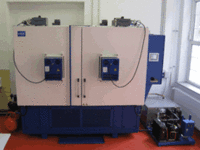
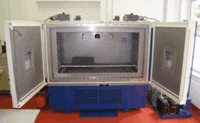
- chamber volume 200 x 100 x100 cm³ (2.0 m³)
- simulation of environmental influences on different materials
- equipment with adsorption dryer, steam humidifier, and mist pan
- temperature range from -40 °C to 100 °C
- adjustable humidity range from 10 % relative humidity to saturated steam
- irradiation with sunlight spectrum, UV-A, and infrared (individual and combined)
- sprinkling with water, temperature adjustable between 10 °C and 40 °C
Contact:
Dr.-Ing. Alexander Flohr
Climatic test chamber Feutron type 3623/16

- simulation of environmental influences with steam humidifier, adsorption dryer, and UV lamp SOL 500
- temperature range from -40 °C to 105 °C in in normal operation mode
- temperature range from -20 °C to 80 °C in sunlight simulation mode
- adjustable air humidity range from 10 % to 100 % in normal operation mode
- adjustable air humidity range from 10 % to 80 % in sunlight simulation mode
- UV spectrum from 295 nm to 800 nm in sunlight simulation mode
- net dimensions of the test chamber: 102 x 77 x 72 cm³
Contact:
Dr.-Ing. Alexander Flohr
Building material test chest WEISS BT 700/40-60 DU
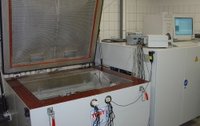
- temperature range from -40 °C to 80 °C
- flooding with tap water, feasible temperature control between 20 °C and 40 °C, flooding height max. 45 cm
- net dimensions of the test chamber: 109 x 75 x 61 cm³
Contact:
Dr.-Ing. Alexander Flohr
Building material test chest Type 4004/01 (Feutron)
- temperature range from -40 °C to 80 °C
- flooding, Raining and Spraying with water, feasible temperature control between 4°C and 40°C, flooding height max. 54 cm
- net dimensions of the test chamber: 200 x 69 x 77 cm³
Contact:
Dipl.-Ing. Alexander Flohr
8-channel ultrasonic measuring system IP-8 (Ultra Test)
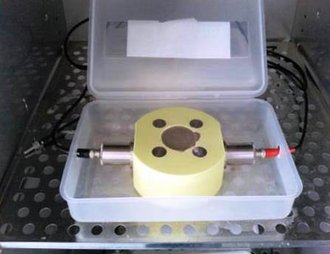
8-channel ultrasonic measuring system IP-8 (Ultra Test)
- determination of setting processes of mineral and polymeric binders at constant temperature (25 °C)
- high-precision measuring system with a resolution of 0.05 µs
- 8 independently controlled channels
- intuitive software for control and evaluation
- measuring duration: 0.5 hours to 31 days
- optional display of velocity m/s or duration µs
- display 1st derivation and temperature during measurement
- display permissible deviations from reference measurements with envelopes
Coupling with shrinkage grooves (100 mm) for simultaneous recording of solidification and hardening processes as well as shrinkage of binders.
Contact:
Dr.-Ing. Stephan Partschefeld
Adhesion Tester - HP 850 (Herion)
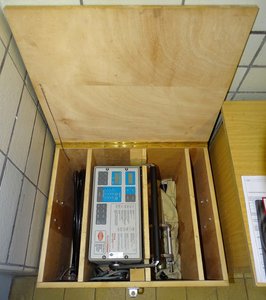
- testing according to DIN ISO 4624 ZIV-SIB 87
- determination of the adhesive or tensile strength of coatings and materials
- system consists of adhesion test control unit and pull piston with test frame
- (pull piston and testing stamp can be exchanged)
Contact:
Dipl.-Ing. (FH) Martin Hampe
Tom Lemphul
Adhesion Tester - F15-D-Easy (Freundl)
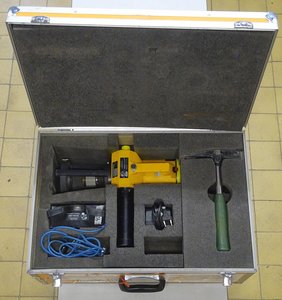
- testing the surface and adhesive tensile strength of building materials and coatings
- conducting feasible in the laboratory or on the construction site
- horizontal and vertical testing
- determination of the adhesive tensile strength in the measuring range 0 to 15 kN
Contact:
Dipl.-Ing. (FH) Martin Hampe
Tom Lehmphul
Adhesion tester - F15D Easy M2000 (Freundl)
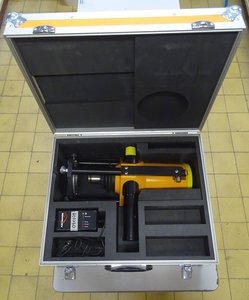
- testing the surface and adhesive tensile strength of building materials and coatings
Digital Rheometer Model DV-III+ (Brookfield)
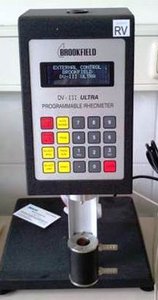
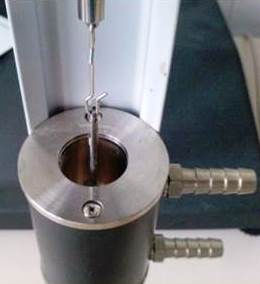
Digital Rheometer Model DV-III+ (Brookfield)
- determination of rheological properties such as viscosity and yield point of liquids, pastes, and suspensions
- measuring spindle SC4-29 and SC4-18
- viscosity range: 25,6 mPa∙s to 20.000.000 mPa∙s
- velocity range: 0.01 to 250 rpm
- measuring cell SC-4 with thermostat chamber
- temperature range: -100°C to 300°C
- measuring computer with data acquisition
Contact:
Dr.-Ing. Stephan Partschefeld
Light microscope Wild Heerenbrugg with Micro Motion camera
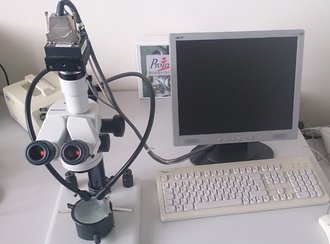
- magnification: 6.4x to 40x
- viewing of specimens on the PC screen by micro-motion lens camera
Contact:
Dipl.-Ing. Stephan Partschefeld
Zeiss Axiotech direct light microscope with Olympus UC30 camera
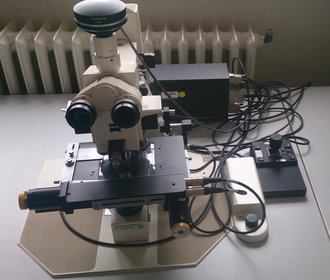
- magnification: 5x to 100x
- microscopy stage: Adjustable in x, y, and z direction
- control of the microscopy stage via joystick
- viewing of specimens on the PC screen due to Olympus UC30 lens camera
- stream motion software for generating projects
- compilation of sharp images of uneven samples by batch processing in z direction
- automatic footage of sample images by Stream Motion software
Contact:
Dr.-Ing. Stephan Partschefeld
Digital microscope camera DigiMicro Mobile by dnt
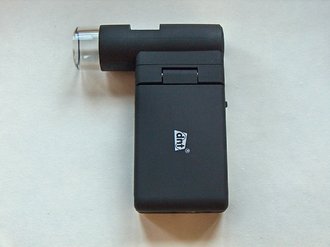
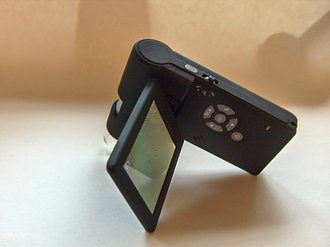
- ideal for portable use
- magnification: 10 to 500 x
- integrated 7.62 cm (3") TFT color display
- lighting: 8 white LEDs (infinitely variable)
- possibility of taking photos or videos
- storage on MicroSD card with 4 GB (max 32 GB possible)
- data transfer via USB
- color: 24-Bit-RGB
- frame rate: max. 30 frames/s
- image format: JPG
- video format: AVI
- shutter speed: 1 to 1/1000 s
- focusing: 10 mm to infinity
- photo resolution: 2592 x 1944 pixels
- video resolution: 640 x 480 pixels
- automatic exposure and white balance
Contact:
Dipl.-Ing. Stephan Partschefeld




